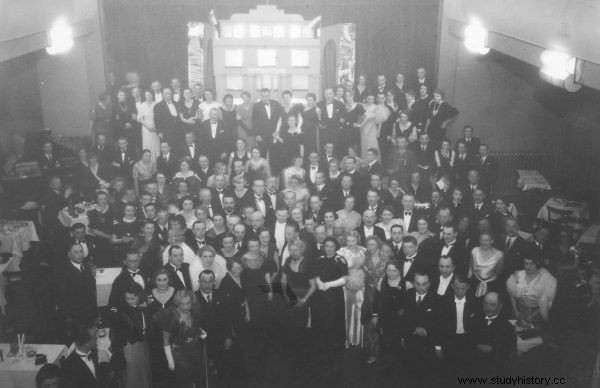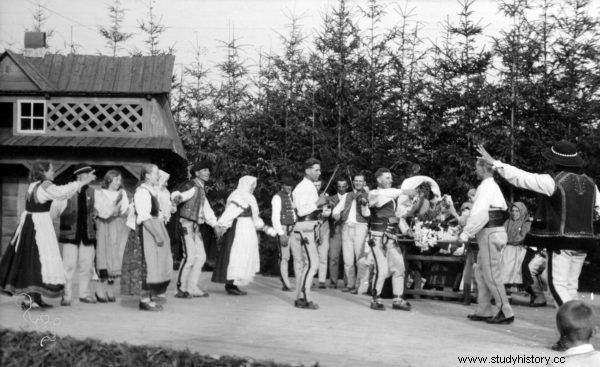Zakopane is a city of love pranks and miracles! Already in the nineteenth century, tourists flocked to the capital of the Tatra Mountains in search of hot cupids. The social cream wanted to have fun, highlanders made their visitors fall in love with their magic, and their parents tried to marry the "old maids", that is ... their twenty-something-year-old daughters.
How to wisely marry my daughter? This question kept the parents of girls from good homes up to sleep. In the nineteenth century, brides could not decide for themselves who to meet, because there was a real danger of being seduced by local don Juan, and thus - losing their innocence and the appearance of a huge stain on the honor of the family.
Fathers and mothers tried to protect their young children from the cupids of not only one-night lovers, but also playboys, candidates with too low social status or those with insufficient wealth. As a result, the young girls transformed into hysterical twenty-something old maids, and the parents had nothing else to do but ... go to Zakopane in search of the perfect candidate for marriage.
Mountain expedition… for a husband
Mountain trips were a popular form of spending free time and making new friends. One such social expedition could count up to 300 people, so the chances of "catching" the right man's daughter were good. Ferdynand Hoesick recalled these entertaining trips as follows:
Mountains, like beautiful nature in general, have the property that they bring people closer together, create a natural, unceremonious relationship between them, in a word they make people feel familiar. One trip taken together has such a psychological impact on two people who did not know each other before that after returning from it, they are on the same footing as if they knew each other since childhood [...].
Familiarity gives rise to sympathy, and sometimes also [...] "bad and evil things, about which the books already piously speak". However, this property is also the good side of Zakopane because I do not suppose that there is a second place in the world where every years there would be as many marriages as here.
Matrimonial fair near Giewont
In Galicia, outside the carnival period, public games could only take place with the permission of the imperial authority. The exception were spa towns, where you could dance and have fun all the time. That is why numerous families with young brides came to the foothills of the Tatra Mountains under the pretext of treating diseases or admiring the wonderful views. In fact, the trip to Zakopane guaranteed parents the chance to get their dream son-in-law during the balls, the so-called marriage fairs.

Ball in Zakopane, Source:National Digital Archives, 1934.
Zakopane balls were considered as exquisite and magnificent as those in Warsaw. Elegant young ladies, accompanied by chaperones (their own mothers), were seated by the walls awaiting an invitation to a dance by a suitable young man. Such outbursts contributed to many propositions, and then to weddings.
In order to attract as many singles as possible, the local press published announcements with the annotation that it was a "hen party".
City of pranks and debauchery
Not only young girls who dreamed of standing on a wedding carpet were heading to Zakopane, but also married women eager for extramarital, forbidden pleasures:
Because in Zakopane air, apart from oxygen, ozone and other secondary chemicals, there is also a pleasantly poisonous gas for which you do not have a protective mask. [...] It is with this air of love, desire, pranks and quarrels that you can breathe in Zakopane.
The hot atmosphere of the capital of the Tatra Mountains spread to everyone. Women in the parks publicly fell into the arms of newly met men, MPs entered into "night coalitions" with MPs from other political options, a married woman from Katowice succumbed to the amor of an official from Grodno, and a student from Lviv became a victim of a "respected citizen from the sea". The whole situation is perfectly illustrated by a joke from the satirical magazine "Stork":
Feminine logic
- Are you going to Zakopane this year?
- Sorry. I cannot leave my husband alone at home.
- Then take him with you.
- Yeah? And why should I go to Zakopane then?
Journalists were eager to publish information about events taking place in Zakopane. The first place for visitors to play was the casino established in 1874 in the house of Józef Krzeptowski, which was moved to the Tatra Manor House 8 years later; then it could boast an individual, spacious ballroom.

Fun in Zakopane, source:National Digital Archives, 1932
Other places for guests eager to have fun were created in hotels and spa establishments. Among the latter locations, Dr. Chramca's facility was particularly popular. Ferdynand Hoesick mentioned the balls there in a letter to "Kurier Warszawski":
The times when dancers were wearing walking costumes and men were in gray jackets are over: today ladies are wearing ball gowns, and dancing teenagers are wearing tuxedos, although tailcoats and white ties predominate. In a word, chic and elegance, nothing less than Western European. Europe is full of its mouths.
The love games of the highlanders
Flirting and love pranks took place not only between tourists who came to Zakopane, but also between locals and visitors.
In order to win the heart of their chosen one, highlanders resorted to unconventional methods. One of the ways was to prepare a special version of a highlander cake. During the new moon the girl had to catch a frog, kiss it on all its legs, then spit and cut the amphibian into four parts, and finally put it in a mosquito net. The dish prepared in this way for the beloved was to guarantee a love success.
Another culinary method was the old Polish method of adding menstrual blood to dishes - equated with sexuality.
In Zakopane and its vicinity, weddings were often concluded out of reason, and decisions about it were made mainly by parents. Hence, the difference in age between the spouses was often over 20 years. Sometimes the family allowed the child to choose a candidate or candidate, but the relationship continued to develop under supervision.

Lviv professors during a sleigh ride in Zakopane, Source:National Digital Archives
It was easier for widows who, after the death of their husband or wife, had their own property and the appropriate status, and could choose themselves with whom they would spend the rest of their lives. Despite this, they often made decisions based on cold calculation, not letting themselves be carried away by the madness of love.
Among the highlanders, the matchmaker service was a popular method of getting the other half. This method ensured that a matchmaker would be blamed for a possible failure, thus avoiding awkward situations . The current activities of intermediaries were known not only to the families, but also to the immediate surroundings of the people who were to become a couple, therefore the arrival of the matchmaker to the candidate's house was very popular among the neighbors.
The work of the matchmaker resembled a kind of theatrical performance, during which the main actor emphasized the advantages and at the same time blurred the disadvantages of his client. These performances were rich in symbolic gestures and understatements. Pure highlander artistry. After the "artistic" part, tough negotiations followed. If a consensus was reached, the terms of the conversation were written down and sealed with booze.

Highlander dances show in Zakopane, Source:National Digital Archives, circa 1925
The social situation and the relationship between locals and tourists in Zakopane are perfectly summed up by a fragment of the text from the 19th-century edition of Tygodnik Ilustrowany, which emphasized that indecent behavior at the foot of the Tatra Mountains largely resulted in:
visits of town lords who, on the one hand, by paying the highlanders for the simplest service, taught them their greed for a penny, and on the other hand, through gifts and recommendations contributed a lot to the spread of immorality among the female highlanders.
However, as Ludwik Zejszner and Wiktor Tissot noted in their accounts - highlanders are not saints and have a fiery temperament, and the relations between future spouses (and not only) were the order of the day. Often, such trysts were organized with the blessing of parents who lent the best room to their young ones. As is often the case, the truth lies somewhere in the middle.
Bibliography:
1. "Stork", publ. 01/06/1903.
2. F. Hoesick, Klimek Bachleda. A handful of memories , "Pamiętnik Towarzystwa Tatrzańskiego" 1911.
3. F. Hoesick, Historical and Literary Sketches and Stories , Warsaw 1900.
4. A. Lisak, Idyllic under the Tatras , Black 2019.
5. J. Palmira, Flirty at Giewont , "Illustrated Daily Courier" 1929.
6. W. Tissot, Cards from the Parisian's Journey , "Przegląd Zakopiański", April 26, 1900.
7. W. Wnuk, My Podhale , Warsaw 1968.
8. L. Zejszner, Podhale and the northern slope of the Tatras, i.e. the Polish Tatras , "Warsaw Library", 1852.
9. Oędziny in the Tatras , "Tygodnik Ilustrowany", March 12, 1864.
